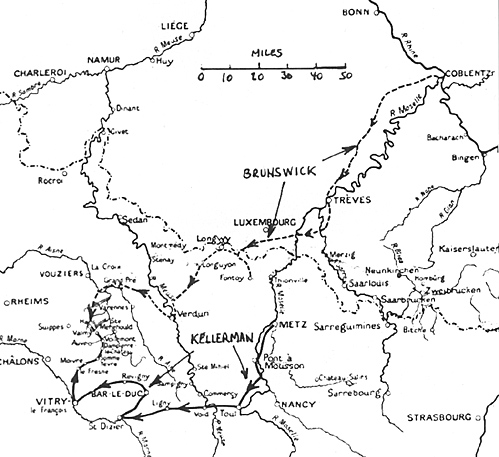The French Assembly declared war on Austria and Prussia on April 20, 1792. Fighting began at once along the Flanders frontier defended by the Armee du Nord.
Volunteers made up the bulk of the Armee du Nord and during the first encounters with the Austrians in the Flanders, they ran away or, at best, were easily brushed aside in the opening combats near Lille, which the Austrians besieged. Disgusted with the conduct of his troops, Marshal de Rochambeau resigned his command of the Armee du Nord. He was succeeded by the Marquis de Lafayette, who had been in command of the Armie du Centre.
On August 10, 1792, a Paris mob helped by the Marseille Federes, stormed the royal palace, massacring the Swiss Guards. Louis the XVIth took refuge with the Assembly and was deprived of his few remaining powers. Lafayette, who had briefly thought of marching on Paris to restore order, was relieved of his command and fled across the frontier to surrender to the Austrians.
Dumouriez was appointed by the Assembly to replace Lafayette in command of the Armee du Nord. The old Marshal, Luckner, was in command of the Armee du Centre and Kellermann commanded the Armee du Rhin.
By July, the Duke of Brunswick [11]
had assembled an army of 80,000 men (42,000 Prussians, 30,000 Austrians and a small contingent of Hessians and French
emigres). By August 19, Brunswick started his invasion of France by crossing the frontier at Longwy. He captured the fortresses of Longwy and Verdun without much opposition. Verdun fell on September 2. Brunswick did not leave Verdun until September 11 and his army moved very slowly through the Argonne Forest. Apparently, Brunswick's objective was Paris.
At that time, Brunswick was opposed by theArmee du Nord under Dumouriez. Dumouriez had only 17,000 men - mostly volunteers - to oppose Brunswick's 55,000 (the rest were in the rear) and Luckner at Metz had but 15,000. Nevertheless, Dumouriez attempted to stop Brunswick at a defile in the Argonne Forest but Brunswick outfoxed him and Dumouriez had to retreat. Then, after crossing the Aisne river, Dumouriez decided to make another stand but for that, very conscious of his weakness, he realized that he needed Kellermann. Consequently, he called Kellermann and asked the government to order Kellermann to join him.
In the mean time, Kellermann had been ordered to march for Metz with 5,000 men from the Armee du Rhin and to replace Luckner in the command of theArmee du Centre. Luckner was promoted out the way as generalissimo of the three armies. On September 2, Kellermann assumed command of the Armee du Centre and he immediately began to reorganize his army from the saddle. With his force from the Armee du Rhin, he had brought Ney who had been promoted adjutant on June 14, 1792. In addition, he retained Berthier as Chief of Staff.
As ordered by the government and answering Dumouriez's direct call for help, Kellermann somewhat reluctantly hastened
[12]
with part of his army to join Dumouriez in an attempt to stop the Prussian advance.
More Battle of Valmy September 20, 1792
 As the menace of war increased at the end of 1791, three armies were formed to defend France's north-east frontier against a probable invasion. The "Armee du Nord", commanded by Marshal de Rochambeau [10]
held the northern fortresses, the "Armee du Centre" was centered in Metz and the "Armee du Rhin" was based around Strasbourg.
As the menace of war increased at the end of 1791, three armies were formed to defend France's north-east frontier against a probable invasion. The "Armee du Nord", commanded by Marshal de Rochambeau [10]
held the northern fortresses, the "Armee du Centre" was centered in Metz and the "Armee du Rhin" was based around Strasbourg.
Introduction
I. The French Army and the Revolution
II. The French Revolutionary Army of the Northeast at the Beginning of the War in 1792
III. Battle of Valmy
IV. Conclusions and the Aftermath of Valmy
Back to Empire, Eagles, & Lions Table of Contents Vol. 2 No. 2
Back to EEL List of Issues
Back to MagWeb Master Magazine List
© Copyright 1993 by Emperor's Headquarters
This article appears in MagWeb (Magazine Web) on the Internet World Wide Web.
Other articles from military history and related magazines are available at http://www.magweb.com
